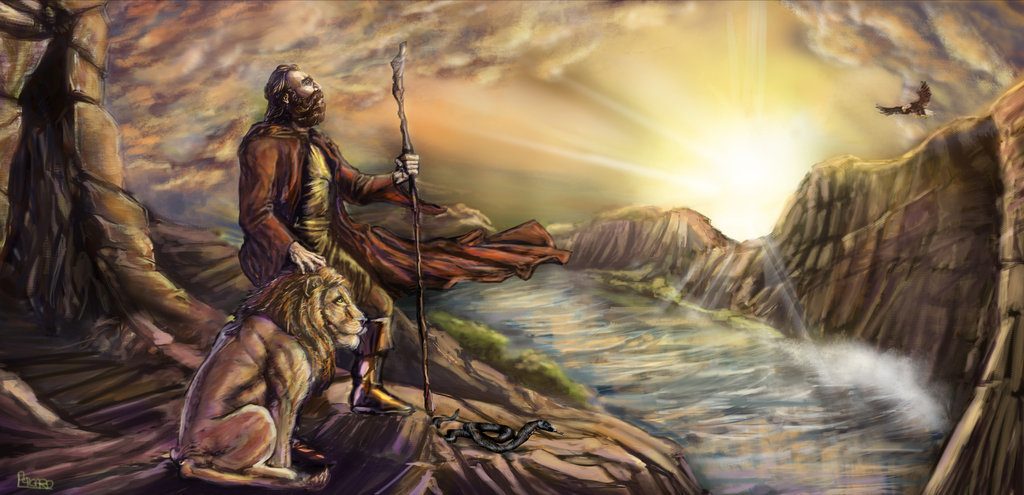Zoroastrianism was a dualist faith that originated in Persia, and over the years it has influenced a number of other faiths. Even though we may not recognize it today, it has been an influence on a number of world religions, especially on Christianity and Islam. Zoroastrianism is a belief system that stresses how we as human beings were meant to strive for our full potential. A primary tenet of the faith is that righteous and upstanding people will participate in the rewards of paradise, while the evil-doers will undergo punishments in hell.1
The prophet and founder of Zoroastrianism was Zarathustra, a man from an aristocratic family in Rhages, Media. Most scholars believe that Zarathustra was born around the late seventh and early sixth centuries B.C.E. He was a priest who became disillusioned with Persian ancestral religion, so instead he decided to search for inspiration and wisdom, and for a deeper meaning to life. After ten years of traveling, he finally realized that he had been called to be a prophet of Ahura Mazda, the Lord of Light. “He received a revelation in the form of the Avesta, the holy book of his religion, and commissioned to preach to humankind.”2 He would preach the Gathas; these were known as the hymns to the gods.
The central claim of Zoroastrianism is that there are two coequal and co-eternal gods: Ahura Mazda, the All-knowing Lord of Light, and Angra Mainyu or Ahriman, the Lord of Darkness. These gods represent an extreme dualism, where followers were given the option of choosing whom to worship. Ahura Mazda would save or condemn individuals based on whichever choice they decided to make.3 The people would experience rewards and punishments based on how they chose to behave. If they followed “Good words, Good thoughts, Good deeds,” they would be able to appreciate all the pleasures Ahura Mazda had in store for them in the afterlife.4

Devotees of Zoroastrianism believed that Ahura Mazda first produced the World of Thought and then gave birth to the World of the Living; but there was not yet life. Angra Mainyu challenged this pre-creation with his own counter-creation in order to destroy what Ahura Mazda was establishing. The Lord of Darkness wanted to demolish it with darkness, sickness, and death. Before Angra Mainyu was able to attack, Ahura Mazda forced him to recoil to the darkness. He was stunned into unconsciousness for three thousand years.5
Ahura Mazda then prepared for the Mixture of war, or battles against evil. This war was going to last six thousand years. For the first three thousand years, Ahura Mazda would unite with other lesser gods so that they could form a broad alliance. Angra Mainyu’s evil queen helped awaken the evil-doer and stirred all evil beings to attack Ahura Mazda. The battle then began, and Ahura Mazda’s creation came to life. Unfortunately, the very first beings killed were good, Gayomard and the Lone Bull; but from their semen they were able to manifest all humankind and bring into being all animals. Ahura Mazda’s right-hand man was Karsasp, a beautiful and innocent man, who helped fight off Angra Mainyu and his servants. Ahura Mazda then put Karsasp into a deep sleep so he would be well-rested for the very Last Battle.6 “At death, according to the tenets of Zoroastrianism, the souls of all persons ascend to the summit of Mount Hara where the good and bad of each soul are weighed in balances.”7 If one has made exceptional choices, ones soul will cross the cosmic bridge and continue an existence in heaven. In the case that many of one’s decisions were unacceptable, the bridge will disrupt and one’s soul will perish in hell. Scholar Charles David Isbell summarizes the eschatology of Zoroastrianism this way: “Since evil will have become extinct, history will come to an end, good souls will receive immortal bodies and will live forever in the re-perfected earth ruled over by Ahura-mazda.”8
This religion has continued to be practiced for as much as three thousand years. There are still a few thousand devotees that continue to carry on the traditions of Zoroastrianism in Iran and in India today. This religion has faced many difficulties in its long history, especially during the seventh century C.E. when invading Arab Muslims conquered the land of Persia, the homeland of Zoroastrianism. The conquerors chose not to take away this religion altogether, but they did choose to put a financial burden on the Zoroastrian temples.9 Many fled to India, which is home today to many of their descendants, known as Parsis. Many of those who stayed in Persia ended up converting to Islam. Although it may not be practiced as widely today, it has made a considerable impact on other religions.
Christianity was one of those religions that may have been influenced by elements within Zoroastrianism. Scholar John R. Hinnells writes,
It is generally held that the form of the later Jewish and Christian concept of the devil or Satan was influenced by Iranian tradition. If this be accepted then it has serious implications for the understanding of the saviour or Messianic figure…. When [the devil] becomes truly demonic … then the savior is given a new task.10
That task, Hinnells believes, was to defeat a supernatural and evil being, which taps into Zoroastrian dualism. In fact, the beliefs in a Satan of evil pitted against a God of good, the belief in angels and demons fighting a cosmic war, and the belief in a savior figure who would save all of humanity from evil and sin are all elements deriving from Zoroastrianism.11 Zoroastrianism in its original form may be an obscure faith in today’s society, but its impact on the fundamental principles of many religions is evident and deserves our appreciation and acknowledgement.
- Jerry Bentley, Herbert Ziegler, Heather Streets Salter, Traditions & Encounters: A Brief Global History Volume 1 (New York, NY: McGraw-Hill Publishers, 2016), 95-99. ↵
- Salem Press Biographical Encyclopedia, 2015, s.v. “Zoroaster,” by J. Steward Alverson. ↵
- Funk & Wagnalls New World Encyclopedia, 2016, s.v. “Ahura Mazda.” ↵
- Bentley, Ziegler, and Street Salter, Traditions & Encounters, 96-97. ↵
- P. Oktor Skjærvø, “Good vs. Evil,” Calliope 15, no. 5 (January 2005): 8. ↵
- P. Oktor Skjærvø, “Good vs. Evil,” Calliope 15, no. 5 (January 2005): 8. ↵
- Charles David Isbell, “Zoroastrianism and Biblical Religion,” Jewish Bible Quarterly (2006). ↵
- Charles David Isbell, “Zoroastrianism and Biblical Religion,” Jewish Bible Quarterly (2006). ↵
- Bentley, Ziegler, and Street Salter, Traditions & Encounters, 97-98. ↵
- John R. Hinnells, Zoroastrian and Parsi Studies: Selected Works of Johr R. Hinnells (Burlington, VT: Ashgate Publishing Co., 2000), 46. ↵
- Bryan Rennie, “Zoroastrianism: The Iranian Roots of Christianity,” The Council of Societies for the Study of Religion vol. 36 no. 1 (2007): 3-5. ↵



89 comments
Ben Kruck
This article did a great job explaining the origin of Zoroastrianism. The principles of Zoroastrianism are what possibly created a lot of modern-day religions, so it is interesting to see where their roots have come from. You did a good job at laying out the details and got straight to the point. Overall, a great article and would recommend for other people to read it!
Javier Oblitas
Before this article I had never heard of the religion Zoroastrianism. This article was very thoroughly researched and provided an amazing means of conveying the information. I saw many similarities between Zoroastriainism and our religions of today! Amazing pictures, punction, as well as information!
Ana Barrientos
I enjoyed reading this article, it was informative and well researched. I have never heard of Zoroastrianism before, so I was super interested in learning more about it. It is super intriguing to me how Zoroastrianism possibly influenced major religions that we know of today. It makes me wonder though, what if this religion never came to be? Where would Christianity and other religions get their influence? Overall, great article!
Jacob Adams
I find it interesting to see where other ideas came from, especially one as big as modern religion. This article made me wonder how do we know all of this information is true if this religion is older than Judaism. Since it was written on rock I guess that means its fact? Even more surprising, there are still people who practice this religion today! This article did a good job of showing just how similar Zoroastrianism is to Christianity.
Matthew Gallardo
Hello Jezel, I was really intrigued at the story of Zoroastrianism. I had no idea of the struggle between the co-existing gods Ahura Mezda and Angra Manyu, nor would I have known about them at all. This article is very well written, from the history of its prophet to the story of the religion itself. I was interested throughout the article and I now want to learn more about this ancient yet still practiced religion!
Derric Standifer
This article was very informal. I didn’t have a clue what Zoroastrianism was or what their beliefs were. The fact that this essay on Zoroastrianism may draw comparisons to other/modern global faiths like Christianity is great. I was shocked to see that there are still believers of Zoroastrianism today. I find it fascinating to observe how different global faiths impact one another.
Morgan Cassias
What an interesting article. Very informational, I had no idea about this religion or the impact it has had on other religions. Great job at sharing about Zoroastrianism! I think you did a great job at relaying the information and not making it seem too over whelming. Awesome pictures, overall such a great article!!!
Gabriella Parra
I’m so glad you wrote this article! I’ve been interested in Zoroastrianism and its parallels to Christianity for a while. I knew there were parallels but it was helpful to see them laid out here because neither the parallels or beliefs of Zoroastrianism are taught in depth in public schools. I plan to do research on this religion, so this article was a valuable refresh!
Carlos Hinojosa
This article did a good job of just getting to the point but still being able to cover all the points they wanted to cover. Zoroastrianism is a interesting religion like you said mostly because other religions even if they didn’t know it at the time were definitely inspired by it. This article did a good job at showing that great work.
Roberto Soriano
Really interesting to see how this ideology shares some common grounds with Christianity, I feel like this article has been well written as it gives a good explanation of what Zoroastrianism is, I think it is more a complex subject therefore the article is a good starting point if you are trying to find more about this subject. It is also really important to state the influence of dualism in this religion and the fight between good and evil as it something common between the majority of religions in the present time.